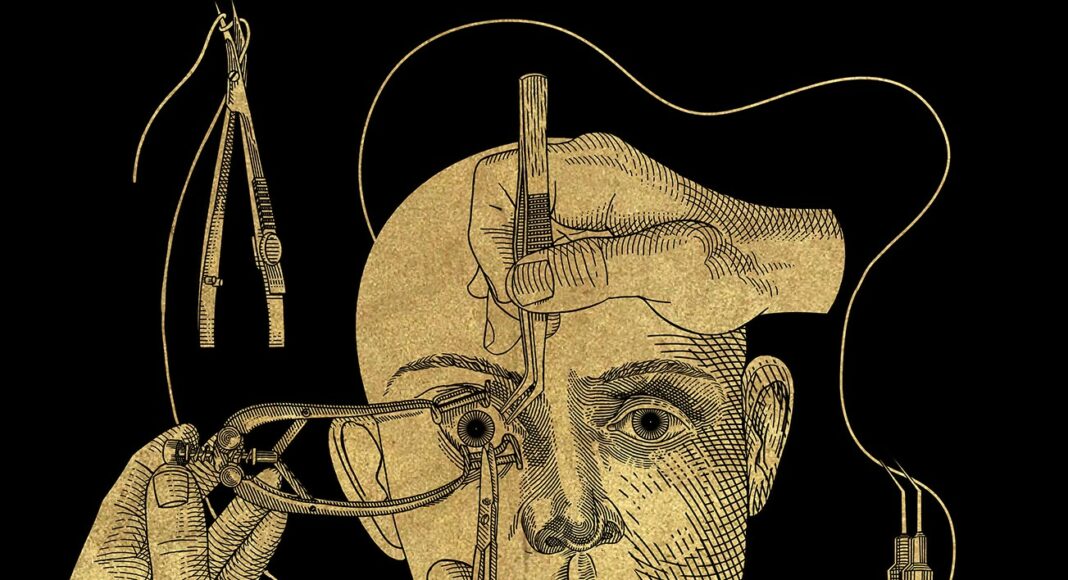Seen from one angle, Imago Philosophia, the current exhibit at San Jose’s Anno Domini Gallery, glistens like the fabled streets of El Dorado. Seen from another, it all slips away into a flat black matte.
Consisting of 73 hand-drawn images printed in gold leaf on black, the exhibit—much like the ideas which inspired it—changes remarkably depending on the observer’s vantage point.
Imago Philosophia is the second exhibit at AD by Spanish artist LeonKa (Leon Kafre), the first being his US debut, 2016’s Things, Mereology and Schemes. That exhibit took some very abstract concepts and vividly displayed them in bright lines of gold.
The artist’s new exhibit continues the gold thematic, but develops on the previous show’s technique and message, depicting many of the images, shapes and conceptual distinctions historically defined by philosophy. Depending on the viewer’s position and the play of light, each image may appear yellow, iridescent, nickel or simply not appear at all.
“I emphasize the models that are used to illustrate theories,” Ka says of the pieces in Imago Philosophia. “In short, black symbolizes the structure, the background or ‘being’ that underlies any figure that appears. The figure, then, becomes ‘illuminated’ against this background of being.”
In a print titled Truth: Metaphysical, Epistemological and Semantical Distinction, a fountain spouts the many slippery forms of truth identified by philosophy: a priori truths, a posteriori truths, necessary, conditional, synthetic and analytic truths. Taken together, there is an effect of observing some hidden totality normally too vast for human view.
Between his last US show and now, Kafre received his PhD in Metaphysics from the Universitat de Barcelona. Unlike the popular image of artists struggling with self and subconscious for creative content, Kafre says his process largely involves research and rigorous theoretical distinction.
“First of all, [I] study the subjects, trying to underline the examples that are presented to illustrate a theory,” he says. Only then, after studying and identifying key conceptual images, does he begin “the illustration of those examples.”
Before becoming a philosopher proper, the artist born Leon Kafre began his career on the street.
“I started writing graffiti in 1991, at the age of 11,” he says over email. By then, he had already begun struggling with large philosophical questions like the existence of God, the nature of numbers and the tricky issue of being itself. Around the turn of the millennium, he says he “started doing something different, closer to what I do now.
“The narrative and the spray technique of graffiti seemed very limited to me, and I wanted to experiment narratively and technically with new forms,” the artist says.
Specifically, he started making massive street murals intricately depicting esoteric knowledge, sacred geometry and metaphysics. The first time AD Gallery director Cherri Lakey saw one of these pieces—2011’s Urbi et Orbi—she was immediately struck.
“It’s funny, because our whole thing is street art and street art as culture, but there was a really tricky time where all of a sudden people thought if you want to get famous just paint something on a wall and throw your website on there,” Lakey says. “But there are these amazing exceptions out there like Leon who are true and intense.”
Much of Imago Philosophia is inspired by the somewhat terrifying thought of Scottish empiricist David Hume. In the 18th century, Hume argued against cause and effect, stating that any knowledge we may have of the supposed law—such as that one pool ball striking another will cause the second to move—is only based on our observation of two disconnected events.
It’s a difficult concept to wrap one’s head around—all the more reason for Ka to represent it artistically. A print hanging on the building’s north wall depicts Hume himself surrounded by his own deductions. Beneath, an image of a billiard ball being struck is broken up into two separate images.
It’s appropriate, then, that Lakey would feel reawakened by LeonKa’s work. The great philosopher Immanual Kant once said that reading Hume awoke him from what he called his “dogmatic slumber.”
“This is the epitome of what art is for: those transcendent ideas and thoughts that we just don’t have the words for,” Lakey says. “It’s a really powerful thing.”
Imago Philosophia
Now Through Oct 16
Thu-Fri 12-7pm, Sat 12-5pm
Free
AD Gallery, San Jose



